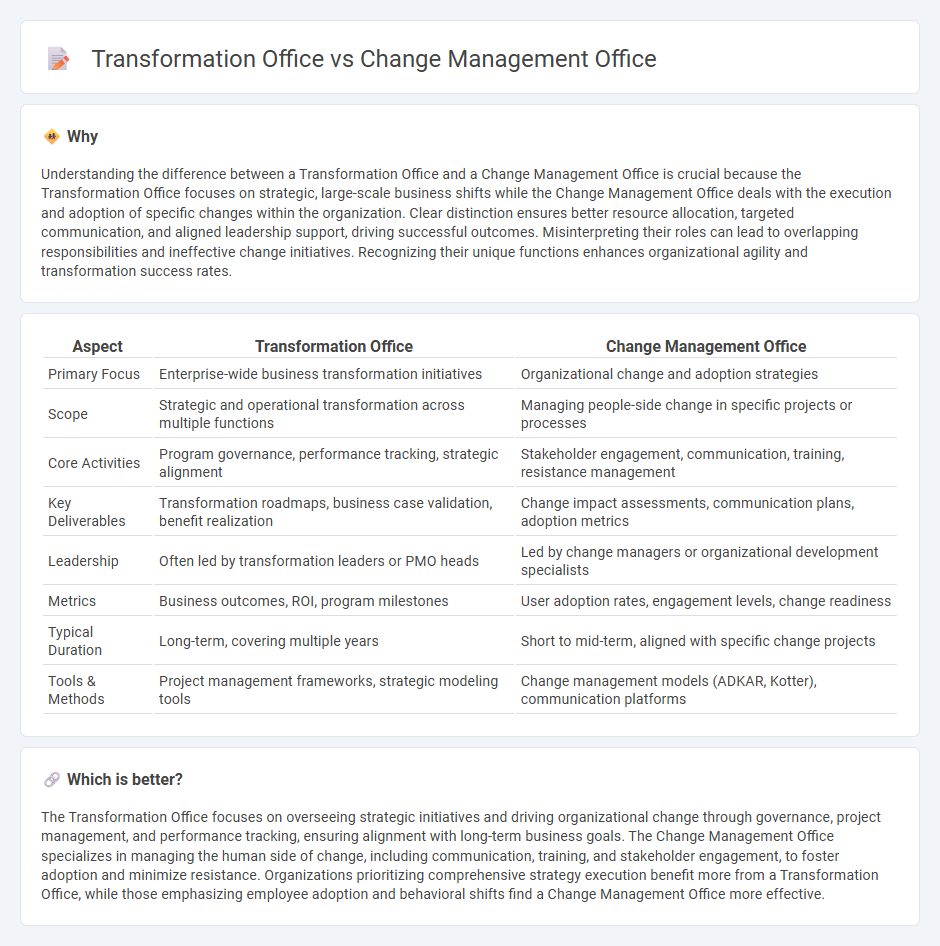
Transformation Office drives large-scale strategic initiatives by aligning organizational goals with execution plans to ensure successful business transformation. Change Management Office focuses on managing people-side change through communication, training, and stakeholder engagement to minimize resistance and empower employees. Explore how integrating both offices can accelerate your company's transformation journey and enhance change adoption.
Why it is important
Understanding the difference between a Transformation Office and a Change Management Office is crucial because the Transformation Office focuses on strategic, large-scale business shifts while the Change Management Office deals with the execution and adoption of specific changes within the organization. Clear distinction ensures better resource allocation, targeted communication, and aligned leadership support, driving successful outcomes. Misinterpreting their roles can lead to overlapping responsibilities and ineffective change initiatives. Recognizing their unique functions enhances organizational agility and transformation success rates.
Comparison Table
| Aspect | Transformation Office | Change Management Office |
|---|---|---|
| Primary Focus | Enterprise-wide business transformation initiatives | Organizational change and adoption strategies |
| Scope | Strategic and operational transformation across multiple functions | Managing people-side change in specific projects or processes |
| Core Activities | Program governance, performance tracking, strategic alignment | Stakeholder engagement, communication, training, resistance management |
| Key Deliverables | Transformation roadmaps, business case validation, benefit realization | Change impact assessments, communication plans, adoption metrics |
| Leadership | Often led by transformation leaders or PMO heads | Led by change managers or organizational development specialists |
| Metrics | Business outcomes, ROI, program milestones | User adoption rates, engagement levels, change readiness |
| Typical Duration | Long-term, covering multiple years | Short to mid-term, aligned with specific change projects |
| Tools & Methods | Project management frameworks, strategic modeling tools | Change management models (ADKAR, Kotter), communication platforms |
Which is better?
The Transformation Office focuses on overseeing strategic initiatives and driving organizational change through governance, project management, and performance tracking, ensuring alignment with long-term business goals. The Change Management Office specializes in managing the human side of change, including communication, training, and stakeholder engagement, to foster adoption and minimize resistance. Organizations prioritizing comprehensive strategy execution benefit more from a Transformation Office, while those emphasizing employee adoption and behavioral shifts find a Change Management Office more effective.
Connection
The Transformation Office and Change Management Office collaborate closely to ensure successful organizational change by aligning strategic initiatives with effective change practices. The Transformation Office focuses on executing large-scale projects and transformation strategies, while the Change Management Office drives adoption and stakeholder engagement through communication and training. Together, they enhance project outcomes by integrating operational execution with behavioral and cultural change management processes.
Key Terms
Governance Structure
The Change Management Office (CMO) typically emphasizes project-level governance, focusing on managing change processes, stakeholder engagement, and communication plans within existing organizational frameworks. In contrast, the Transformation Office is responsible for overarching governance structures that align strategic initiatives, resource allocation, and performance metrics to drive large-scale business transformation. Explore deeper insights on structuring effective governance for both offices to maximize organizational agility and success.
Stakeholder Alignment
The Change Management Office primarily drives stakeholder alignment by managing communication, training, and resistance to ensure seamless adoption of organizational changes. The Transformation Office, while also focusing on stakeholder engagement, emphasizes broader strategic initiatives and cross-functional alignment to achieve long-term business transformation goals. Explore how these offices collaborate to optimize stakeholder alignment and organizational success.
Program Execution
The Change Management Office (CMO) specializes in managing organizational changes by focusing on stakeholder engagement, communication strategies, and training programs to ensure smooth adoption of new processes. The Transformation Office, however, drives broader strategic initiatives by overseeing complex, multi-dimensional projects that align with long-term business goals and digital innovation efforts. Explore how aligning program execution with these distinct roles can accelerate successful organizational outcomes.
Source and External Links
Best 2024 Guide to Establish and Manage a Change Management COE - A Change Management Office (CMO) is an internal group in an organization that provides change management services and support through a "Change Management as a Service" approach, with its own mandate, strategies, and policies essential for effective change management.
Change Management Office - Benefits and Structure - The CMO serves as an organization-wide authority to govern and implement change initiatives, providing services such as progress reporting, prioritization of initiatives, benefit identification, and risk management, ensuring changes are coordinated across all business functions.
Establishing an Effective Change Management Office for Organizational Evolution - The CMO supports internal change initiatives by leveraging consistent methodologies and plays a critical role in shaping and maintaining organizational culture aligned with the desired brand and values.
 dowidth.com
dowidth.com